Front helps teams of all types — customer support, marketing, and sales — manage communications. It offers major features like a universal inbox, plus real-time collaboration tools like internal notes, shared drafts, and guest accounts. A few different automation features are also available, though most are limited to higher-cost plans.
Front’s biggest differentiator from the competition is the ability to use personal email accounts within their software. Having that added personal touch is a great feature for certain teams, though others may prefer to present a unified voice by having everyone respond from one central email address (e.g., info@), which is also possible with the platform.
Though Front is a great tool, there are some limitations to the product. First, it’s missng a knowledge base tool, so you’ll need to purchase an additional service if you plan on offering users self-service support.
Another disadvantage is the cost. Front's base plan is very competitively priced, but it has a cap of 10 agents and doesn’t include some basic, key features like analytics (it’s only available on their $49/agent and $99/agent per month plans), which is a big hindrance when trying to understand your business' needs.
What that all adds up to is that Front may work well for a period of time, but eventually many teams outgrow their offering. Since switching tools isn’t the simplest task, some teams may find it better to look to some of Front's alternatives for a long-term solution.
The 12 best Front alternatives for support teams
Front makes a solid product, but it may not be the right fit for every team. If you're thinking you may need a different shared email solution, we’ve put together a list of 12 Front alternatives to consider:
Help Scout
HubSpot
Google Collaborative Inbox
Hiver
Kayako
Freshdesk
Zendesk
Missive
SharedInbox
Drag
Trengo
Crisp
1. Help Scout
Best Front alternative for growing businesses and organizations.

Help Scout was built specifically to help teams better communicate with their audience, and all of its features are designed with your customers, patients, students, colleagues, and team members in mind.
In addition to shared team inboxes, you can use Help Scout to build a knowledge base with Docs, provide live chat support through Beacon, and deliver proactive communication using Messages, making it easy to scale as your team and channel requirements grow.
Help Scout's reporting features give you access to pre-built dashboards that allow you to better understand team performance, see where you’re excelling, and identify areas for improvement. And Workflows let you automate routine tasks to improve team productivity.
Finally, Help Scout integrates with many popular third-party SaaS tools like Salesforce, Asana, Intercom, Shopify, HubSpot, and Jira. So if you’re looking for a user-friendly email management platform that addresses your current and future needs, Help Scout’s certainly one to consider.
Price: Free trial available. Plans start at $20/user per month.
Learn more about Help Scout:
2. HubSpot Service Hub
Best Front alternative for HubSpot users.
HubSpot is well known for its CRM, but a few years ago, it launched Service Hub, a product designed to help support teams manage customer communication. The platform offers a free plan that includes a shared inbox and supports email and live chat channels. The freemium option also has basic reporting dashboards.
Prospective customers should note that Service Hub’s free plan is missing features like a knowledge base builder, voice channel support, automation capabilities, user roles, and team management functionality. These features are limited to the platform’s paid plans, which can be cost-prohibitive to smaller teams.
However, if your company uses other HubSpot products like its CRM or Marketing Hub, Service Hub will integrate seamlessly. Connecting your company’s existing tech stack with your help desk can help your team deliver a more personalized support experience.
Price: Free plan available. Paid plans start at $45 per month.
3. Google Collaborative Inbox
Best Front alternative for those looking for a free shared inbox tool.

If you’re a small team and are already using Gmail as your email provider, Google Collaborative Inbox could be a good first step. It’s a free tool that lets your employees all work out of a shared mailbox.
It is not the most advanced offering, but it does help streamline some of the email management processes and make conversations more transparent to your entire team.
Price: Free, though it does require a Google Workspace account.
4. Hiver
Best Front alternative for Gmail users that want to offer additional channels.
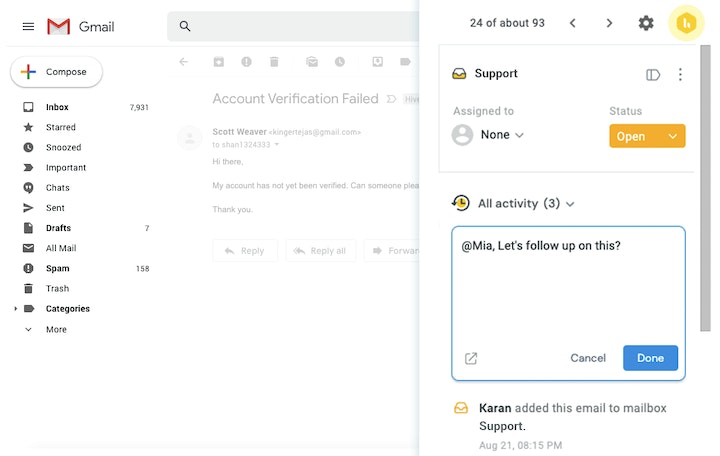
For teams using Gmail but finding they want a little more functionality than Google Collaborative Inbox offers, Hiver could be a great option. It allows you to continue using a Gmail address but gives access to some more advanced features like internal notes, light automation, and the ability to assign tickets to different agents.
Though it is a great shared email inbox, some basic features like customer satisfaction surveys (CSAT), shared views, integrations, automations, and analytics are only offered on their higher-cost plans.
Price: Free trial available. Plans start at $15/user per month.
5. Kayako
Best Front alternative for IT support.

Kayako offers a full support platform, including email, live chat, social media, and self-service channels. The service includes features like internal notes, collision detection, macros, automatic workflows, and reporting.
A unique aspect of choosing Kayako is that they offer an on-premise solution in addition to their cloud offering. This is helpful for IT teams or organizations that need to keep their data stored on local servers.
Smaller teams may find Kayako’s high price tag ($125 per agent, per month) prohibitive given that other tools have similar features for half the price.
Price: Free trial available. Plans start at $125/agent per month.
6. Freshdesk
Best Front alternative for teams offering email and phone support.
For teams looking for help desk functionality, Freshdesk is worth looking into. Freshdesk helps you manage email and social (Facebook and Twitter) communications all in a single inbox.
You’re also able to build out a knowledge base for FAQ content, connect to other software using apps in their marketplace, use their iOS and Android mobile apps, and do some automations like email routing and assignment to improve productivity.
Freshdesk also offers a few more features like advanced reporting, chatbots, and the ability to send satisfaction surveys when an issue is closed, but these features are only offered on their higher-tiered plans.
Price: Free trial and plan available. Paid plans start at $15/agent per month.
7. Zendesk
Best Front alternative for enterprise companies.

Zendesk is one of the most recognizable names in customer support software. Though most think of them for larger teams due to the cost and complexity of onboarding the tool, they do offer non-enterprise level plans.
Zendesk helps you resolve issues over email, social, phone, and chat. You can also build out a knowledge base or use their apps for things like adding a chatbot. Zendesk even offers more advanced features like AI and customizable analytics dashboards, though those are limited to their higher-cost plans.
Price: Free trial available. Plans start at $19/agent per month.
8. Missive
Best Front alternative for teams looking for project management capabilities.

For teams looking for a multifunction support and project management tool, Missive could be a good option. It’s basically a blend of a shared inbox, live chat, and project management software. You can also manage social media messages, though not all social media platforms are included (Twitter is an additional charge).
It may seem like a bit of a hodgepodge on the surface, but there is good functionality, and the ability to do things like create and assign tasks can improve team collaboration. They also have some basic automations and integrations you can use to improve productivity.
Price: Free trial and plan available. Paid plans start at $14/user per month.
9. SharedInbox
Best Front alternative for Slack power users.
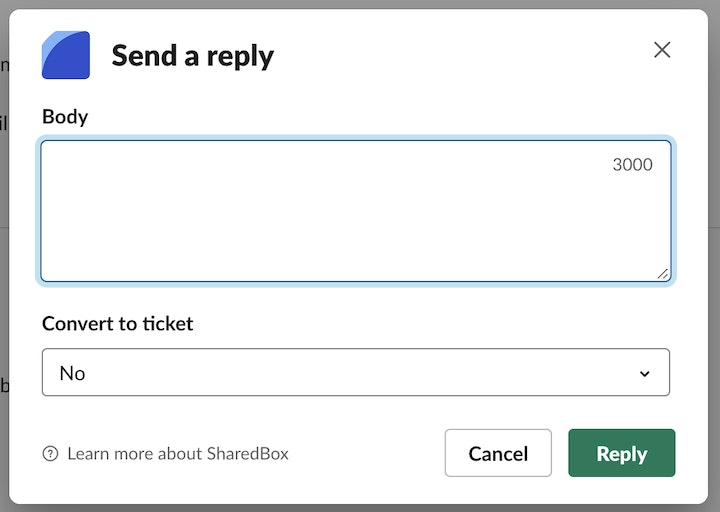
If you’re a team of Slack power users, SharedInbox may be a great solution for you. Their tool allows you to manage and respond to requests directly from Slack. Basically, you create Slack channels for different email domains (support, sales, etc.), and people send in requests from a support site.
Though it’s a bit of a different process on the front end, after someone sends their initial message, the interaction happens in email just as it normally would. You can even set up things like autoreplies and custom email signatures.
Price: Free trial available. Plans start at $5 per month.
10. Drag
Best Front alternative for teams looking for a cross-functional tool.
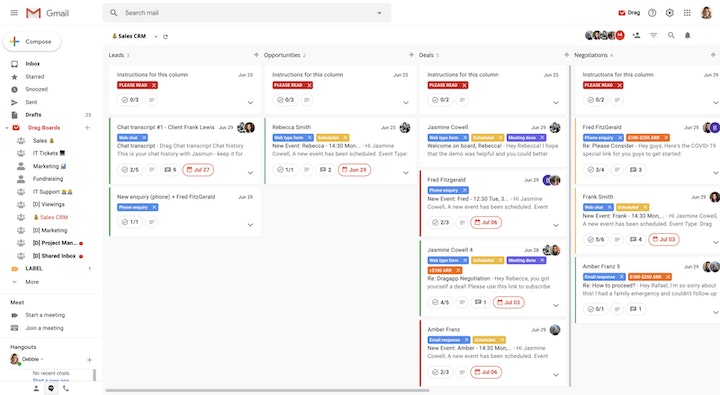
If you’ve ever wished your shared inbox functioned like a kanban board, then Drag is the tool for you. Similar to Hiver, it connects with a Gmail account, but the interface allows you to sort emails on a kanban board for easy organization and team transparency.
Similar to other offerings on the list, there are some automation and team collaboration features, as well as some project management functionality included. It can fill multiple team needs, but the downside is it’s lacking live, proactive, and self-service communication tools.
Price: Free plan available. Paid plans start at $5/user per month.
11. Trengo
Best Front alternative for teams offering support across a multitude of channels.
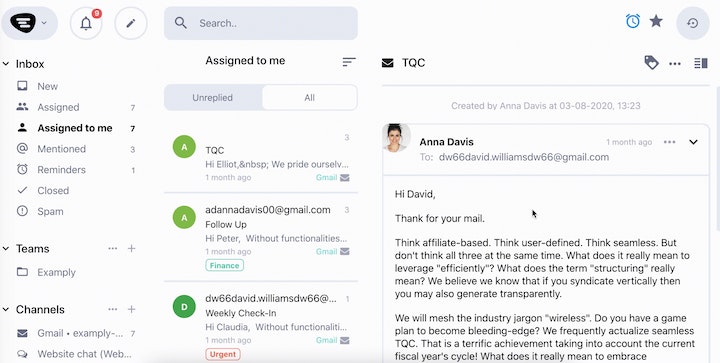
It seems every day there’s a new communication channel people want to contact you from. Some want to text you, others want to @ you on social media, and some still prefer talking on the phone. When you start adding in all those channels, managing conversations can get tricky fast.
Trengo built a platform that allows you to manage all those channels in one place. It should be noted, though, that some channels and related functionality are limited to higher-tiered plans. Along the same lines, their entry-level plan doesn’t include reporting dashboards, which may be a deal breaker for some teams.
Price: Free trial available. Plans start at $18/agent per month.
12. Crisp
Best Front alternative for teams wanting to improve cross-team collaboration.
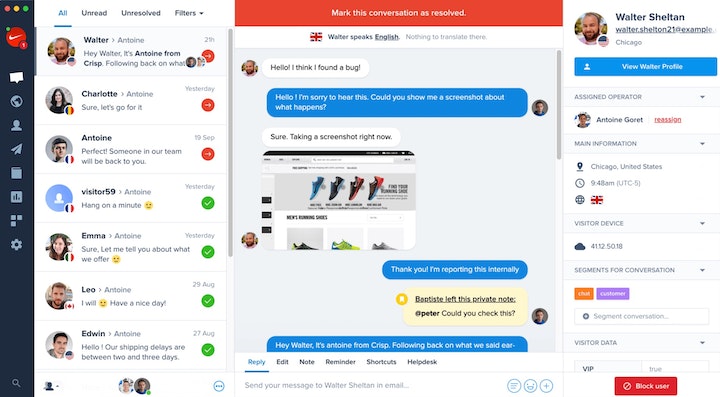
Similar to some other offerings on the list, Crisp is a combination tool, but it does have shared inbox capabilities. They also have some CRM functionality, as well as the ability to create in-app messages.
Though lack of focus on one key area could be difficult, Crisp could also help bring multiple teams together by housing their efforts all in one place. It also gives further transparency across teams, so everyone stays in the loop.
Price: Free plan available. Paid plans start at $25/workspace per month.
Making a final decision
For some, Front is the perfect option. If you’re a team looking to use personal email addresses to interact with your audience, you may well be one of them. However, if you envision expanding your communication offerings in the future, Front may not be what’s best suited for your team.
Before you decide on investing in any software, do your best to fully understand your current and future needs. Also, don’t shy away from doing a trial or two to get an idea of what different options have to offer; an informed decision is usually the best one!














